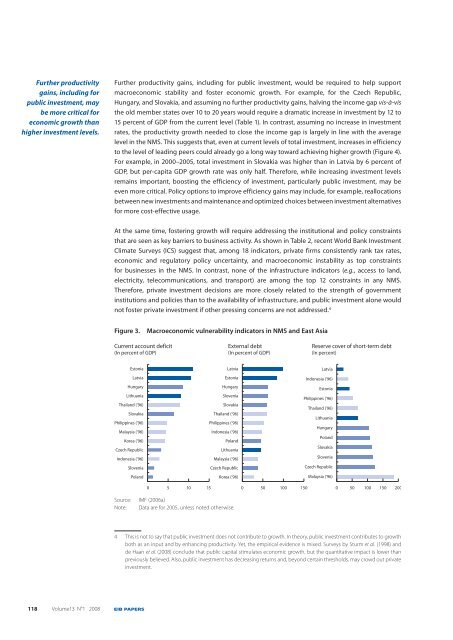EIB Papers Volume 13. n°1/2008 - European Investment Bank
EIB Papers Volume 13. n°1/2008 - European Investment Bank
EIB Papers Volume 13. n°1/2008 - European Investment Bank
You also want an ePaper? Increase the reach of your titles
YUMPU automatically turns print PDFs into web optimized ePapers that Google loves.
Further productivity<br />
gains, including for<br />
public investment, may<br />
be more critical for<br />
economic growth than<br />
higher investment levels.<br />
118 <strong>Volume</strong>13 N°1 <strong>2008</strong> <strong>EIB</strong> PAPERS<br />
Further productivity gains, including for public investment, would be required to help support<br />
macroeconomic stability and foster economic growth. For example, for the Czech Republic,<br />
Hungary, and Slovakia, and assuming no further productivity gains, halving the income gap vis-à-vis<br />
the old member states over 10 to 20 years would require a dramatic increase in investment by 12 to<br />
15 percent of GDP from the current level (Table 1). In contrast, assuming no increase in investment<br />
rates, the productivity growth needed to close the income gap is largely in line with the average<br />
level in the NMS. This suggests that, even at current levels of total investment, increases in efficiency<br />
to the level of leading peers could already go a long way toward achieving higher growth (Figure 4).<br />
For example, in 2000–2005, total investment in Slovakia was higher than in Latvia by 6 percent of<br />
GDP, but per-capita GDP growth rate was only half. Therefore, while increasing investment levels<br />
remains important, boosting the efficiency of investment, particularly public investment, may be<br />
even more critical. Policy options to improve efficiency gains may include, for example, reallocations<br />
between new investments and maintenance and optimized choices between investment alternatives<br />
for more cost-effective usage.<br />
At the same time, fostering growth will require addressing the institutional and policy constraints<br />
that are seen as key barriers to business activity. As shown in Table 2, recent World <strong>Bank</strong> <strong>Investment</strong><br />
Climate Surveys (ICS) suggest that, among 18 indicators, private firms consistently rank tax rates,<br />
economic and regulatory policy uncertainty, and macroeconomic instability as top constraints<br />
for businesses in the NMS. In contrast, none of the infrastructure indicators (e.g., access to land,<br />
electricity, telecommunications, and transport) are among the top 12 constraints in any NMS.<br />
Therefore, private investment decisions are more closely related to the strength of government<br />
institutions and policies than to the availability of infrastructure, and public investment alone would<br />
not foster private investment if other pressing concerns are not addressed. 4<br />
Figure 3. Macroeconomic vulnerability indicators in NMS and East Asia<br />
Current account deficit<br />
(In percent of GDP)<br />
Estonia<br />
Latvia<br />
Hungary<br />
Lithuania<br />
Thailand (’96)<br />
Slovakia<br />
Philippines (’96)<br />
Malaysia (’96)<br />
Korea (’96)<br />
Czech Republic<br />
Indonesia (’96)<br />
Slovenia<br />
Poland<br />
0 5 10 15<br />
Source: IMF (2006a)<br />
Note: Data are for 2005, unless noted otherwise.<br />
External debt<br />
(In percent of GDP)<br />
Latvia<br />
Estonia<br />
Hungary<br />
Slovenia<br />
Slovakia<br />
Thailand (’96)<br />
Philippines (’96)<br />
Indonesia (’96)<br />
Poland<br />
Lithuania<br />
Malaysia (’96)<br />
Czech Republic<br />
Korea (’96)<br />
0 50 100 150<br />
Reserve cover of short-term debt<br />
(In percent)<br />
Slovakia<br />
Slovenia<br />
Czech Republic<br />
Malaysia (’96)<br />
0 50 100 150 200<br />
4 This is not to say that public investment does not contribute to growth. In theory, public investment contributes to growth<br />
both as an input and by enhancing productivity. Yet, the empirical evidence is mixed. Surveys by Sturm et al. (1998) and<br />
de Haan et al. (<strong>2008</strong>) conclude that public capital stimulates economic growth, but the quantitative impact is lower than<br />
previously believed. Also, public investment has decreasing returns and, beyond certain thresholds, may crowd out private<br />
investment.<br />
Latvia<br />
Indonesia (’96)<br />
Estonia<br />
Philippines (’96)<br />
Thailand (’96)<br />
Lithuania<br />
Hungary<br />
Poland

















